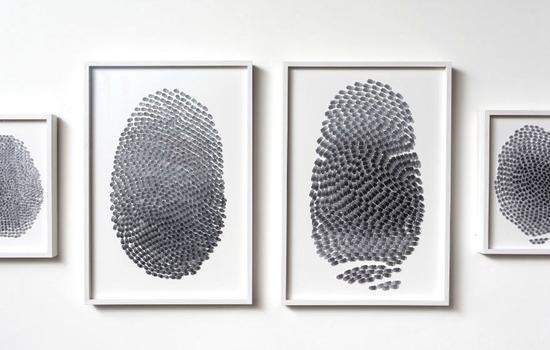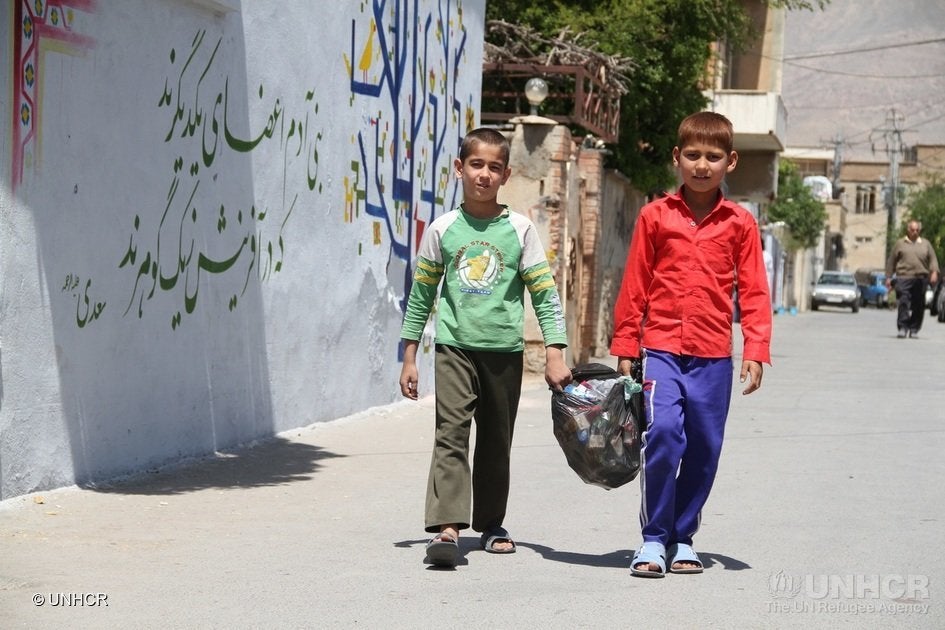
Tindar is an Italian artist who was born in Rome in 1986. He is haunted by the question of tracks, traces, and impressions.
Give me a friend, he seems to say.
A chance encounter.
A gallery owner, a collector who commissions a work, a relative.
What interests me are their prints.
Specifically, their fingerprints, those markers of identity that, in our modern societies, fingerprints are taken to be.
And, from a fingerprint recorded on a sheet of blank paper he began making dozens and sometimes hundreds of copies that he then cuts out, mixes with others’ fingerprints, and impales on tiny metal pins that are themselves affixed to a canvas that he has covered with acrylic paint so as to resemble the earth.
From these swarms of fingerprints duplicated and gathered into shadowy but distinct unities he composes immense portraits that, from the moment I first saw them last year in Paris, have reminded me of Man Ray’s imaginary portrait of the Marquis de Sade, which was made up not of fingerprints but of stones from the Bastille.
°°°°
Enter the migrant crisis.
Like all of us, Tindar is shocked at the spectacle of the tens of thousands of people streaming out of Syria, Afghanistan, Eritrea, and Sudan—people who, upon arrival, are often herded into pens like cattle.
But more than the rest of us, he is struck by the fact that the first thing the immigration authorities do when the migrants appear at the border of the Schengen area, fresh from the hell of famine, dictatorship, and war, is to process them—by taking their fingerprints.
Is life imitating art, he wonders?
Or is it the other way around? Is art being called forth by the brutality of regulations that require the new migrants to file their asylum application in the country where they were fingerprinted (which has the double effect of shifting the bulk of the burden onto the shoulders of the countries, notably Greece and Italy, closest to the migrants’ points of departure and of inducing migrants who wish to rebuild their lives in a northern European country but who were fingerprinted in Kos or Lampedusa to burn the ends of their fingers to make their prints unrecognizable)?
Whatever the answer, Tindar goes to Calais, which is, for many migrants, the end of the line.
He mingles with the aid workers who have come to lend a hand to the vast crowd of poor people hanging on in the unsanitary makeshift camps that soon came to be known simply as “the jungle.”
And there he has a simple idea.
To take, once more, the migrants’ fingerprints.
But, even more, to reverse the paradigm by sending the migrants out to take the fingerprints of local residents.
And, from this mixed bag, he makes a new series of works that will be on exhibit, starting Thursday, at the Saatchi Gallery in London as part of the Start Art Fair, prior to an auction in Paris this winter to benefit the aid organizations working in Calais.
°°°°°
It’s a beautiful story. For four months running, this jungle, this human dump, will have served as the stage for a strange ballet in which migrants, armed with ink and sheets of paper, went off in search of residents to fingerprint. Some slammed the door in their visitors’ faces, insulted them, or chased them away, but most went along with the game and so found themselves—for a brief moment suggestive of carnival, Saturnalia, or civil disobedience—in the situation of the refugees.
The fable is even more beautiful. Because nothing so resembles a fingerprint as another fingerprint. No matter how much we like to think of them as absolute markers with the power to impart, in the words of Michel Foucault in The Order of Things, an “unmistakeable visibility” to identities “freed from any perceptible charge,” fingerprints alone do not allow us to distinguish a Sudanese from a European official, or from a journalist sent to cover the dismantling of the southern end of the camp, or from a resident of the city witnessing this more or less disturbing phenomenon. The result is that these new triptychs composed of thousands of undissociated fingerprints function as a powerful symbol of our common history, of our own share in our shared identity, and of what bonds us, even in this mark that is supposedly the most intimately singular mark of an individual.
But most beautiful of all are the works themselves, great triptychs composed of long trails of fluid forms, milky ways in shifting shades of grey, darkening here, brightening there, irresistible sinuosities that strike one as metaphors of exile and the road. A well-ordered Pollock. A random Tachist action painting. An embodiment of the divisionism invented by Georges Seurat, who brought forth shape, color, and light from a dispersion of dots. Or perhaps, from this field of fingerprints trembling on their slender, nearly invisible stalks, one hears rising the echo of ancient sounds that swirl in the evening air to the rhythm of a waltz or a dizzy spell. Tindar is a sensitive and knowing artist. Original and cultivated. Why would it be surprising that this young master, who spent his apprentice years copying the Florentine painters of the sixteenth century (Raphael, Correggio) and the Bolognese of the seventeenth (Carracci, Guido Reni), should discover the most pictorial of the French poets?

